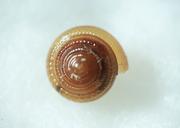Low-
Moderate
The population size of the crowned tightcoil is low and the trend is unknown. These terrestrial snails are very rare and have distributions that include small, isolated populations, perhaps remnants of previously much wider ranges. These small, isolated populations, often associated with old-growth and/or riparian hardwoods and are very vulnerable to logging, road building, fires, or other disturbances.
Description and Range
Physical description
Taxonomic note: crowned tightcoil is in the family Pristilomatidae.
Ecology and life history
The crowned tightcoil has been collected in moist leaf and woody debris litter in low elevation forested areas under the dense thickets of salal (Gaultheria shallon) near the coastal beaches, and in riparian areas under red alder and swordfern. It is associated with riparian and old-growth habitat, though it has been collected in the headwater riparian areas of managed second-growth western hemlock forests. These snails are typically associated with abundant, persistent moisture.
Land snails are hermaphroditic and exchange gametes with other conspecific individuals when conditions are favorable, typically in the spring, and then both will lay eggs in damp subsurface situations where the eggs will be relatively safe from predators and desiccation. Land snails do not tend their eggs or young. There is no larval stage and newborn snails look like miniature adults (the innermost part of the shell develops within the egg).
Snails need moisture, so where the habitat dries out, they will estivate in the summer, become active with fall rains, and hibernate when the season turns cold.
Land snails eat plants (living or dead), fungi, fruit, microorganisms, litter, wood, and dead animals.
Daily refugia used during moist seasons can be down wood, rock or accumulations of litter.
During the summer, snails are found deep in talus accumulations which are adjacent to springs or streams and which serve as refuge sites from desiccation and protection from predators while the snails are immobile. These deep rock refugia also provide the important, environmentally stable sites needed to survive wildfire events and cold winter conditions.
Mollusks which inhabit talus habitats also utilize the surrounding forest areas during moist, cool conditions, ranging out from the refugia provided by the rocks to forage in the adjacent forest floor litter.
Geographic range
The crowned tightcoil is known from Pacific County, Washington and the Northern Coast Range of Oregon; there are also historical records from Portland. This snail has also been found in Clallam County, Washington, and is suspected to occur in Grays Harbor, Wahkiakum, Cowlitz and Clark Counties, Washington and Multnomah, Clatsop and Columbia Counties, Oregon.
For a map of range-wide distribution and conservation status of this species, check out NatureServe Explorer.
Climate vulnerability
Sensitivity to climate change
Low
There is limited information on the sensitivity of the Crowned tightcoil to climate change. There is very limited information on this species’ life history, although it is associated with riparian and old growth habitat. Its abundance is closely correlated with cool, moist conditions. Activities or events that alter conditions, such as moisture levels, shade, and temperature, may make this species vulnerable.
Exposure to climate change
Moderate
- Increased temperatures
- Reduced soil moisture and/or drought
- Altered fire regimes
Conservation
Conservation Threats and Actions Needed
- Fish and wildlife habitat loss or degradation
- Threat: Habitat loss to development.
- Action Needed: Technical assistance to regulatory agencies.
- Agriculture side effects
- Threat: Logging of mature timber.
- Action Needed: Develop management recommendations.
- Resource information collection needs
- Threat: Need to delineate distribution of this species.
- Action Needed: Conduct an inventory of this species.
See the Climate vulnerability section for information about the threats posed by climate change to this species.
Resources
References
Applegarth, J. S. 2000. Management recommendations for terrestrial mollusk species Megomphix hemphilli the Oregon Megomphix. Version 2.0. Unpublished report to the Oregon Bureau of Land Management. 39 pp.
Burke, T. E. 2013. Land Snails and Slugs of the Pacific Northwest. Oregon State University Press, Corvallis, OR. 344 pp.
Duncan, N. 2005. Conservation Assessment for Monadenia fidelis minor, Dalles Sideband. Originally issued as Management Recommendations by T. R. Weasma, 1998. Revised by N. Duncan. USDA Forest Service Region 6 and USDI Bureau of Land Management, Oregon and Washington, 14pp.
Frest, T. J. 1999. A Review of the land and freshwater Mollusks of Idaho. Final report to the Idaho Conservation Data Center, Idaho Department of Fish and Game, 600 South Walnut, P.O. Box 25, Boise, Idaho 83707. 281 pp. plus appendices.
Hendricks, P., B. A. Maxell and S. Lenard. 2006. Land Mollusk Surveys on USFS Northern Region Lands. A report to the USDA Forest Service, Northern Region. Montana Natural Heritage Program, Helena, Montana. 11 pp. plus appendices.
NatureServe. 2014. NatureServe Explorer: An online encyclopedia of life [web application]. Version 7.1. NatureServe, Arlington, Virginia. Available http://explorer.natureserve.org. (Accessed September 11, 2014 ).
Pilsbry, H. A. 1948. Land Mollusca of North America (north of Mexico). Monograph of the Academy of Natural Sciences of Philadelphia, 2(2): 521-1113.
Stone, T., 2009. Crowned Tightcoil (Pristiloma pilsbryi). Species Fact Sheet. Interagency Special Status/Sensitive Species Program, Forest Service, Bureau of Land Management. 5pp.
USFWS. 2011. Endangered and Threatened Wildlife and Plants: 90-day finding on a petition to list 29 mollusk species as threatened or endangered with critical habitat: proposed rule. Federal Register 76 (No. 193, October 5, 2011): 61826-61853.
